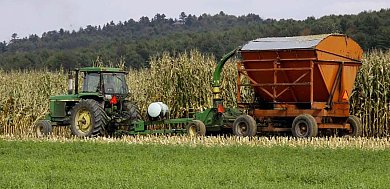COLUMBUS — How to price corn for silage is a perennially challenging question. The best answer will vary depending on the point of view: Are you buying or are you selling?
The corn silage pricing discussion is based on a typical corn crop standing in the field. The goal is to recover the cost of producing and harvesting the corn while still making a profit.
Corn price
The base price of the corn would be the price the farmer could receive for the crop minus the harvest, drying and storage costs. Hopefully, this would meet the goal of covering production costs and generate a profit.
To the grain farmer, the corn crop may have more value than just the income from the sale.
If the crop is sold as silage, the corn fodder is no longer available as ground cover, a source of nutrients or organic matter. This creates an opportunity for the dairy to provide some nutrients and organic matter to the corn fields from subsequent manure applications.
Corn value
To look at the value of the corn as silage, we can estimate that a ton of silage, on average, contains seven bushels of corn.
If corn is worth $3.70 per bushel then the standing corn for silage would be worth $26 a ton before the cost of harvesting for grain. It could also be between $23.50 and $24.50 per ton depending on the yield, assuming the cost for a grain harvest is around $40 per acre. This is a value for corn silage at 35 percent dry matter.
Prices also have to be adjusted for different dry matter concentrations. If dry matter was 30 percent, then the silage value is about $20 per ton. Corn chopped at more than 38 percent dry matter or less than 30 percent dry matter not may not ferment properly and can be a problem. The price of corn silage that has improperly fermented should be discounted.
Two methods
At the 2009 Tri-State Dairy Nutrition Conference, Normand St-Pierre reviewed two methods for valuing silage. The first was valuing corn silage using the seven bushels of corn per ton method plus harvest and storage costs, while considering a fermentation loss at 10 percent.
The second, known as the Sesame pricing method, determines the value of silage by measuring its value against a wide selection of feed prices while factoring in harvesting and storage costs.
The ratio of the two methods, for 2005 to 2008, was 1.27. This means the nutrient value of silage to the cow was potentially worth up to 27 percent more than value based on the market price for corn.
The Sesame value for Ohio corn silage is available in the current edition of the Buckeye Dairy News available online at http://dairy.osu.edu.
The last factor affecting the value of standing corn is risk. Risk that the corn will ferment properly; be harvested at the right time; or that the nutrient count will be acceptable.
The price for the standing crop should be discounted to recognize these risks.
The right amount of discount though is not easy to determine. It is one of the factors to consider when negotiating a price. Also important are both parties agreeing on price, payment method, crop measurement, restrictions and similar details before the crop is harvested.
The agreement should be in writing and signed by both parties especially with large amounts of crops are being sold.
While this type of contracting may be uncomfortable for some producers, it forces the parties to discuss issues up front and can minimize misunderstandings after harvest.
STAY INFORMED. SIGN UP!
Up-to-date agriculture news in your inbox!













